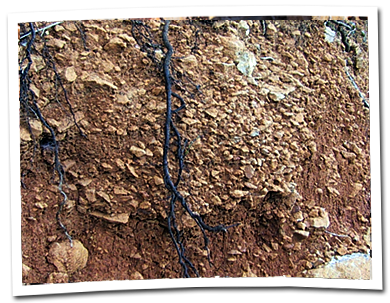

Terroir has become a trendy word. Especially «great terroir». Who doesn’t have one, or claim to have one? At Clos des Fées, our decision to work in this abandoned corner of the Agly valley is, above all, due to a geological map.
This large colourful map may essentially be a geologist’s paradise, but for us, it made us realise how fantastically diversified the geology of this part of the world is. One can only find such diversity in Alsace and… Madagascar! The wide range of rocks and soil types are complemented by a variety of exposures. Some north facing slopes called the «bacs» (bottom of the slopes) barely see a few hours sun in winter. Others facing due south could have tropical plants if it wasn’t for the droughts, sometimes severe. In this area, just barely a few kilometres, one climbs over 350 metres (1150 ft). In these terroirs, harvest never begins before October 15th. Did you say «Mediterranean» climate?
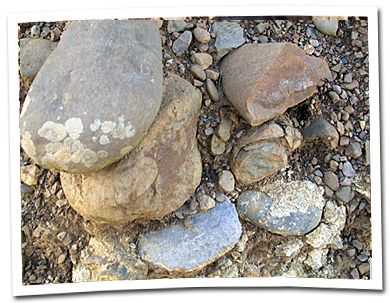

How can one bring soil back to life? Don’t expect us to criticise our ancestors. Without getting rid of weeds, the hillside vineyards would have been uprooted: For the past 15 years, the Roussillon area already lost 15,000 hectares (37,066 acres) of old hillside Carignan…
Some winegrowers still fight; the Roussillon has the largest number of old vines in France, thanks to the courage of the older generation. They have been tending these «ribes» (terraces on steep slopes) all their lives. They planted, grafted, ploughed with horses and worked with the «bigo», the traditional two-pronged tool.
We try, whenever possible, to revitalise soils by introducing biologically active compost like horse manure, by careful plowing, by using products that treat nature as gently as possible. This can be quite easy on some plots; on others we just have to try harder…
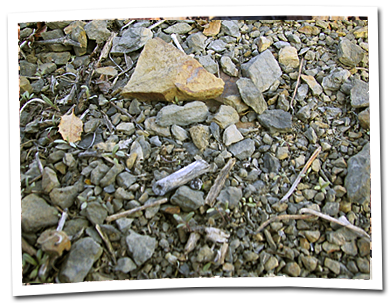

Our vines are tended by sustainable farming practices. Or should we say sensible practices? We check on each of our 112 different plots several times a week in order to make the best possible decision for treatments (or lack of). This decision is based on of the threshold of tolerance of each disease.
Depending on the grape varieties and where they are planted, certain plots hardly get treated at all, others a bit more. This may imply five sprayings of sulfur against grey rot, and one of copper against powdery mildew. On more than half of the estate, sexual confusion techniques produce good results against eudemis and cochylis.
The high levels of copper, and their sterilising effects, increasingly found in humid regions are not customary here. The dry and windy climate helps us minimize the use of chemicals and in smaller quantities.
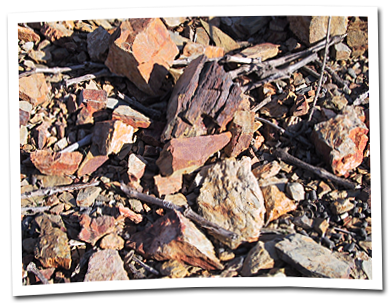

How can one help a great terroir express itself? Re-discovering old ways does not imply a refusal to use modern techniques. For example, exploiting the latest research on Mycorrhiza Fungi (microscopic mushrooms that help the root system select its food), which we sowed on our first parcels starting in 1999. Naturally present in the soil, these had been destroyed by years of poor soil practices, some micro-organism like Endomycorrhizal Fungi, live in symbiosis with the root system. The external mycelium of the mushroom acts as an extension of the root system, strengthening it, improving its nutrition and reinforcing the plant’s immune system. With 40 hectares (99 acres) of vineyards in production, the domain sustains the ecosystem of 100 hectares (247 acres) including moorlands, resting plots, woodlands, edges as well as a group of traditional vernacular buildings. Biodiversity is not here a theory: it is concrete, practical and active.
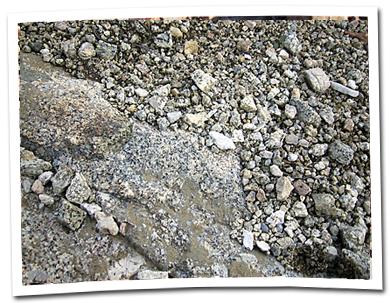

The plots from the estate’s vineyard are far apart one from another. This is one of the factors for the quality of our wines. Travelling 15 kilometres (9.3 miles) in one direction, then 12 (7.46 miles) in another is the price to pay for having exceptional grapes to vinify.
And things are not about to get easier. The granite-based soils of Bélesta and Lesquerde located 30 kilometres (18.6 miles) apart are treasure troves. In the past, people would go on foot to their plots, often walking for over an hour and a half, having set out before daybreak. So what’s wrong with driving 45 minute with a tractor or a truck?
The Japanese are adepts of «reverse thinking». Easier said than done! Having our plots located so far apart makes things more complicated and expensive. But during the harvest, this wide variety of flavors and ripening gives us unlimited possibilities. Things become clear, and wash away any fatigue and problems.
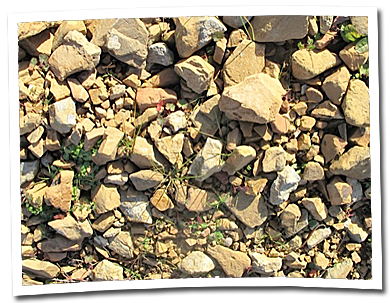

Geology and exposure are essential factors in understanding a terroir, at least if the goal is to create a unique wine, harmonious, able to give a simple emotion or an existential experience. But «history» of the vine is equally important. Having the chance to inherit old vines, we always try to know who planted them, with which technical means, at what period, why and in which economic and cultural context? Vines are clearly a continuation of a «family» story, which alone gives the key of understanding each terroir and identify the course of actions to take. In addition to Genotype (soil, subsoil, preparation, and genetic quality of the plan) you also have «Phenotype», which includes an ensemble of acquired characteristics from the climate to human intervention, good or bad. Only by incorporating the concept of «gestalt» association between a place, a plant and men, that terroir can take his meaning.
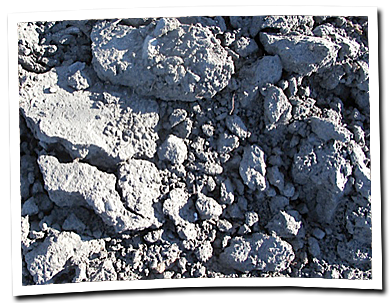

Should the vines suffer in order to express themselves? Do the poorest terroir, the most miserable vines; exhausted winemakers produce the best wines? That was my belief 15 years ago. I don’t believe it anymore today. Still, low yields seem to be more than ever the keystone for a great wine. But for a wine for lunch, or a weekend, an everyday wine, festive, delicious with bright fruit and youth, healthy vines with balanced nutrition and regular supply of water are more likely to produce pleasant wines that everyone can understand and enjoy. To further improve the fruit and tension of the Sorcières, we «adopted» in 2011 a new terroir by Espira de l’Agly. The result: wine bursting with energy and fruit, beyond our expectations, and a perfect blend of old Grenache and hillside Carignan.













